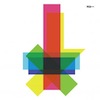KTL, "V"
 A large portion of this album was recorded in two great bastions of European electroacoustic music, namely INA-GRM in Paris and Stockholm’s EMS. While Peter Rehberg and Stephen O’Malley have always brought avant garde electronics to KTL’s sound, there is a much tighter focus on the sort of textures and structures that I would expect from composers like Bernard Parmegiani or Tod Dockstader. Even Mark Fell’s colorful artwork is reminiscent of INA-GRM’s own designs for their box sets of Parmegiani and Luc Ferrari. This is nothing short of a perfect meeting between KTL’s metal tinged atmospheres and the great electronic music experiments of the 20th century.
A large portion of this album was recorded in two great bastions of European electroacoustic music, namely INA-GRM in Paris and Stockholm’s EMS. While Peter Rehberg and Stephen O’Malley have always brought avant garde electronics to KTL’s sound, there is a much tighter focus on the sort of textures and structures that I would expect from composers like Bernard Parmegiani or Tod Dockstader. Even Mark Fell’s colorful artwork is reminiscent of INA-GRM’s own designs for their box sets of Parmegiani and Luc Ferrari. This is nothing short of a perfect meeting between KTL’s metal tinged atmospheres and the great electronic music experiments of the 20th century.
From the opening moments of "Phill 1" (perhaps a nod to Phill Niblock as well as the City of Prague Philharmonic who appear on "Phill 2"), it is clear that the duo will not be revisiting the wintery studies of previous recordings. Sustained tones, softly and slowly overlapping and phasing, reach out of the stereo like tendrils of new growth. The vague threat present throughout KTL’s back catalog is still here but whereas earlier albums were like a stiletto in the back, V feels more like being in the presence of a large, powerful creature that does not view you as a threat and will probably leave you alone. Probably.
The music comes close to O’Malley’s work in Sunn O))) during "Tony." The guitar becomes more prominent and the full, wall of amps sound that O’Malley is best known for comes through in spades. The addition of bass makes the low end rumble even more pronounced and before long, I forget that this is KTL that I am listening to. However, when Rehberg’s echoing computer generated sounds appear, I am quickly reminded of who this is.
The aforementioned "Phill 2" is undoubtedly one of the stand out pieces on V, the City of Prague Philharmonic playing an arrangement by Jóhann Jóhannsson to accompany O’Malley and Rehberg’s modular synth work from the EMS studio. The violins emerge suddenly from the gloom and at first it is difficult to tell where the synthesizers end and where the orchestra takes over. As the piece develops, the elements become more distinct and complex; the strings are tense and soaring while the electronics bubble and hum beneath the surface. When the brass cuts through, it shines brightly like a beam of divine sunshine in the darkness.
V finishes where KTL as a concept started, with a soundtrack to a Gisèle Vienne work. "Last Spring: A Prequel" ties in beautifully with the electroacoustic influences dotted throughout the album as it sounds very much like the sort of experimental hörspiel works practiced by the European avant garde and it even nods toward the music theater works of Einstürzende Neubauten or Nurse With Wound’s monologue pieces like "A New Dress" or "I Was No Longer His Dominant." The text is in French and difficult to follow with my rusty French and unfortunately there is no transcription let alone a translation in the sleeve notes. The monologue performed by Jonathan Capdevielle is given center stage; the incidental music is minimal, mostly concrète sounds and cavernous ambiences. It is creepy stuff, especially given Capdevielle’s strange vocal contortions.
In addition to the main album, the first 300 copies of the vinyl version of V come with a bonus 12" of sessions from INA-GRM. The four pieces (entitled "Study B" through "Study E") are looser than the main album, the duo obviously experimenting with the various bits of equipment in the GRM studio. Each piece has its own character but none of them fit entirely with the bulk of V; "Study E" sounds more like Fennesz than KTL. As a result, I can see why these pieces have been relegated to this 12" yet, that is not to say they are throwaway extras. They are bloody good tracks and would have made a nice EP on their own.
Since KTL’s inception, O’Malley and Rehberg have followed a singular path in terms of composition and mood. With V, they surprisingly break the mould and create something entirely unexpected. This is a great album, possibly their best one to date. With any luck they will continue along this path and develop this take on electroacoustic music further into realms unknown.
This review was made with a copy of the album on vinyl, so unfortunately there are no sound samples. Apologies for this inconvenience.
 




